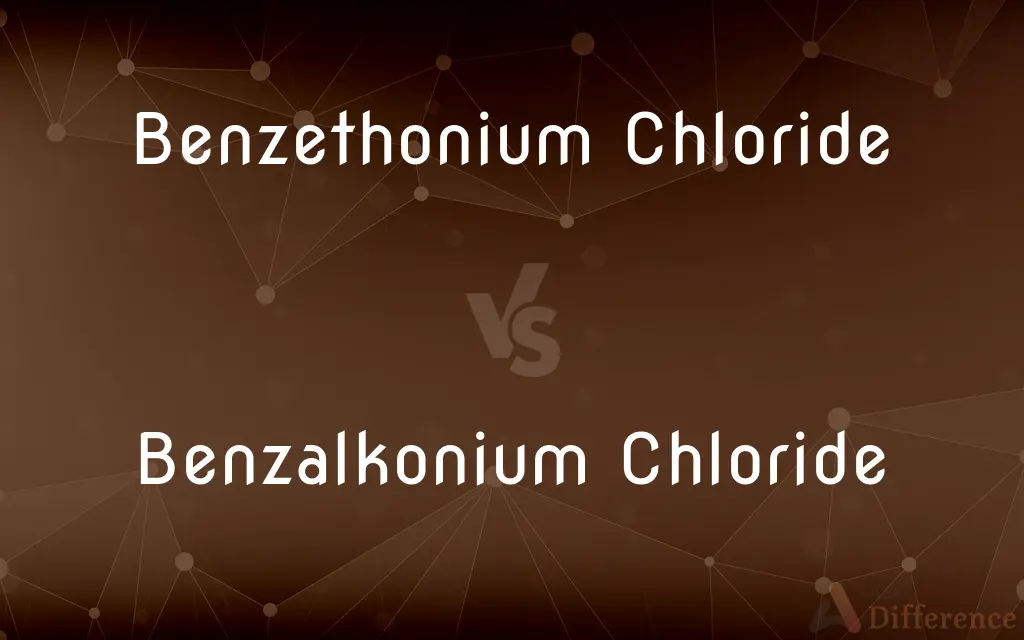Benzethonium Chloride vs. Benzalkonium Chloride — What's the Difference?
By Tayyaba Rehman — Published on November 3, 2023
Benzethonium Chloride and Benzalkonium Chloride are both quaternary ammonium compounds used as antimicrobials, but they differ in molecular structure and usage.

Difference Between Benzethonium Chloride and Benzalkonium Chloride
Table of Contents
ADVERTISEMENT
Key Differences
Benzethonium Chloride, a synthetic quaternary ammonium salt, is prominent in various industrial applications, such as a phase transfer agent in the synthesis of organic compounds. Benzalkonium Chloride, on the other hand, widely recognized for its robust antimicrobial properties, is utilized in numerous medical and personal care products. Each molecule, while showcasing disinfectant capabilities, embodies unique applications due to specific characteristics derived from their molecular structures.
Benzethonium Chloride's prominence in non-consumer products largely stems from its efficacy in facilitating chemical reactions, particularly in the realm of organic synthesis. Benzalkonium Chloride, with its potent antiseptic attributes, is prevalent in products like hand sanitizers, wet wipes, and eyedrops, establishing a closer connection to consumer health applications. The ability to thwart bacterial growth is a shared attribute, but the specified realms in which they’re utilized showcase stark contrasts in their day-to-day applications.
Understanding the structural nuances of Benzethonium Chloride and Benzalkonium Chloride may seem intricate due to their chemical similarities. Both compounds, enveloping nitrogen atoms bonded to alkyl groups, exhibit surfactant properties, hence, their applications as antimicrobials. But the structural differences, albeit subtle, are pivotal in determining their relative effectiveness, stability, and suitability in various applications, positioning each compound uniquely in diverse industries.
Diving deeper into safety aspects, Benzethonium Chloride is not typically found in products that require prolonged skin contact due to its potential skin irritancy. In contrast, Benzalkonium Chloride, being somewhat milder, is frequently formulated into skin-contacting products like cosmetics and personal care items, albeit within regulatory guidelines to ensure safety. Thus, formulators and chemists often find themselves carefully navigating through the unique properties and restrictions of each compound to ascertain their optimal application.
In pharmacological settings, Benzethonium Chloride sometimes serves as a preservative in specific pharmaceutical formulations, ensuring the longevity and stability of the product. Benzalkonium Chloride, however, is notably used in various formulations, serving not only as a preservative but also as an active ingredient in certain antiseptic and disinfectant products. Both compounds have established themselves as integral components within the pharmaceutical and personal care industries, albeit with visibly demarcated domains of applications and regulatory frameworks.
ADVERTISEMENT
Comparison Chart
Usage
Widely used in industrial applications
Commonly used in medical and personal care items
Skin Contact
Limited use in skin-contacting products due to potential irritancy
Utilized in skin-contacting products
Function in Pharmaceuticals
Often used as a preservative
Used as a preservative and sometimes an active ingredient
Antimicrobial Properties
Exhibits antimicrobial properties
Noted for its strong antimicrobial properties
Structural Complexity
Generally a simpler structure
Possesses a more complex structure
Compare with Definitions
Benzethonium Chloride
Preservative: Inhibits the growth of microbes in products.
Example: Some nasal sprays contain Benzethonium Chloride as a preservative.
Benzalkonium Chloride
Biocide: A substance that can destroy living organisms.
Example: Benzalkonium Chloride acts as a biocide in certain water treatment applications.
Benzethonium Chloride
Synthetic Compound: Manufactured quaternary ammonium salt.
Example: Benzethonium Chloride is synthesized for various industrial applications.
Benzalkonium Chloride
Preservative: Utilized in formulations to prevent microbial contamination.
Example: Benzalkonium Chloride is employed as a preservative in eye drops.
Benzethonium Chloride
Antimicrobial Agent: Benzethonium Chloride inhibits microbial growth.
Example: Benzethonium Chloride is often used in sprays as an antimicrobial agent.
Benzalkonium Chloride
Antiseptic: Benzalkonium Chloride is used to prevent bacterial infections.
Example: Benzalkonium Chloride is a key ingredient in many over-the-counter antiseptic sprays.
Benzethonium Chloride
Surfactant: Reduces surface tension in the materials it’s incorporated into.
Example: The formulation utilized Benzethonium Chloride for its surfactant properties.
Benzalkonium Chloride
Detergent: Exhibits cleansing properties, often used in cleaning agents.
Example: The hand wash contains Benzalkonium Chloride, serving as a detergent.
Benzethonium Chloride
Phase Transfer Catalyst: Facilitates the transfer of a reactant from one phase to another.
Example: In the lab, she used Benzethonium Chloride as a phase transfer catalyst in organic synthesis.
Benzalkonium Chloride
Disinfectant: Utilized to inhibit bacterial growth on surfaces.
Example: She cleaned the counter with a solution containing Benzalkonium Chloride.
Common Curiosities
How is Benzalkonium Chloride typically applied in personal care items?
Benzalkonium Chloride is used in personal care items, such as hand sanitizers and wet wipes, due to its antimicrobial properties.
What are the structural differences between Benzethonium Chloride and Benzalkonium Chloride?
Although similar, they differ in molecular structure, influencing their effectiveness and stability in various applications.
Is Benzalkonium Chloride used in water treatment?
Yes, it can be used as a biocide in certain water treatment applications.
What is Benzethonium Chloride commonly used for?
It is often utilized in industrial applications and as a preservative in certain pharmaceutical formulations.
Are Benzethonium Chloride and Benzalkonium Chloride safe for skin contact?
Benzalkonium Chloride is commonly used in skin-contacting products, while Benzethonium Chloride is limited due to potential irritancy.
Can both compounds be used as antimicrobial agents?
Yes, both Benzethonium Chloride and Benzalkonium Chloride exhibit antimicrobial properties but are used in different applications.
Is Benzalkonium Chloride utilized in medical settings?
Yes, Benzalkonium Chloride is used widely in medical settings due to its strong antimicrobial and antiseptic properties.
Can Benzalkonium Chloride be used as a disinfectant?
Yes, it is commonly utilized as a disinfectant to inhibit bacterial growth on surfaces.
Can I find Benzethonium Chloride in consumer products?
It is less common in consumer products than Benzalkonium Chloride due to its potential skin irritancy.
Are these compounds used in the pharmaceutical industry?
Both are used in pharmaceuticals, with Benzethonium Chloride often serving as a preservative and Benzalkonium Chloride sometimes being an active ingredient.
Are Benzethonium Chloride and Benzalkonium Chloride toxic?
They can be toxic at high concentrations, and usage in consumer products is regulated to ensure safety.
What roles do these chemicals play in personal care and pharmaceutical products?
Benzethonium Chloride is used primarily as a preservative, while Benzalkonium Chloride can serve as both a preservative and an active ingredient.
Are Benzethonium Chloride and Benzalkonium Chloride interchangeable in formulations?
Not always, due to differences in their structural complexity, antimicrobial strength, and skin irritancy potential.
How do these compounds act as surfactants?
They reduce surface tension in the materials they are incorporated into, aiding in the mixing of liquids and solids.
How does Benzethonium Chloride serve as a phase transfer catalyst?
It facilitates the transfer of a reactant from one phase to another in the synthesis of organic compounds.
Share Your Discovery

Previous Comparison
Coking Coal vs. Thermal Coal
Next Comparison
Animal Cell vs. Human CellAuthor Spotlight
Written by
Tayyaba RehmanTayyaba Rehman is a distinguished writer, currently serving as a primary contributor to askdifference.com. As a researcher in semantics and etymology, Tayyaba's passion for the complexity of languages and their distinctions has found a perfect home on the platform. Tayyaba delves into the intricacies of language, distinguishing between commonly confused words and phrases, thereby providing clarity for readers worldwide.













































